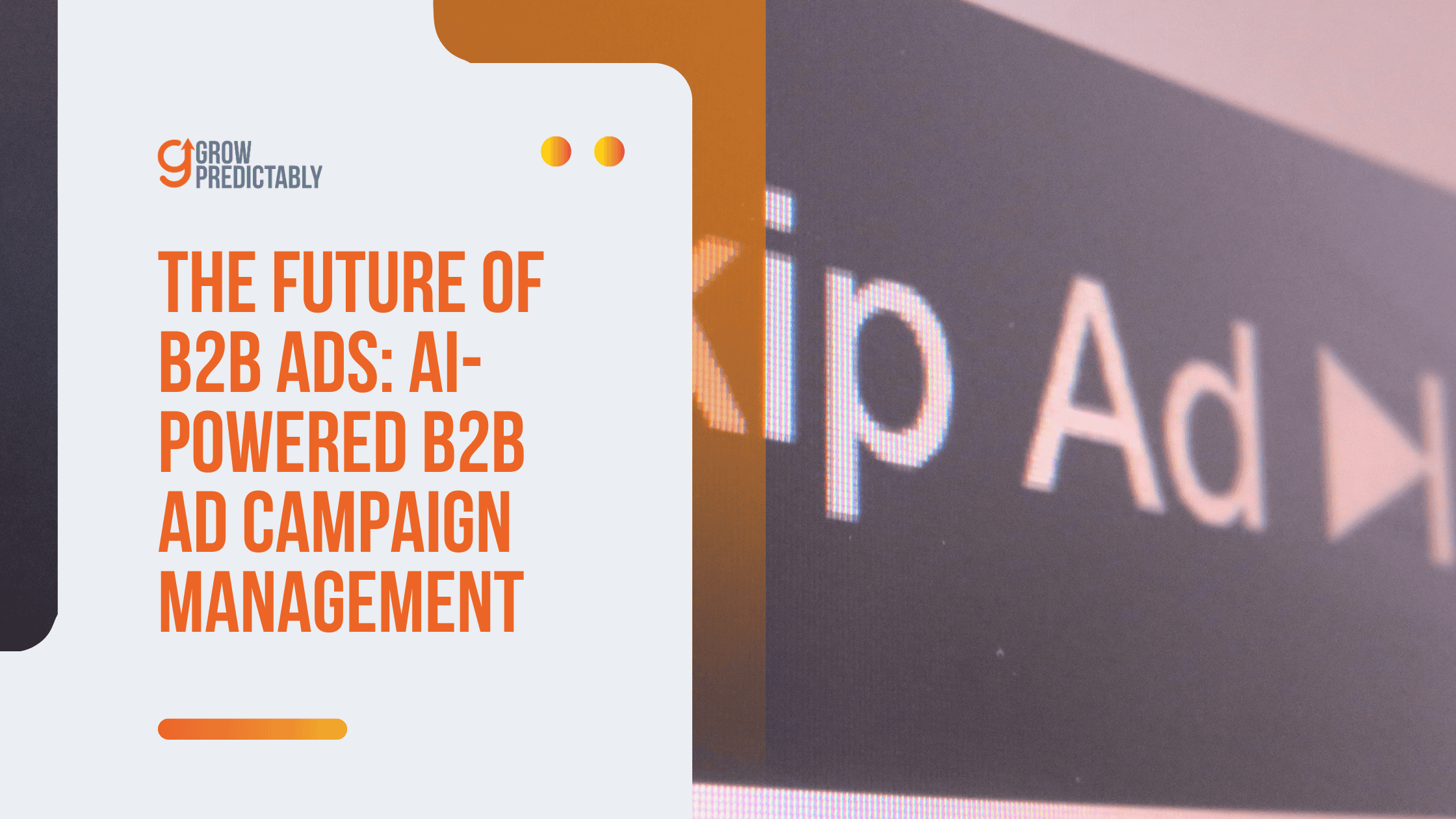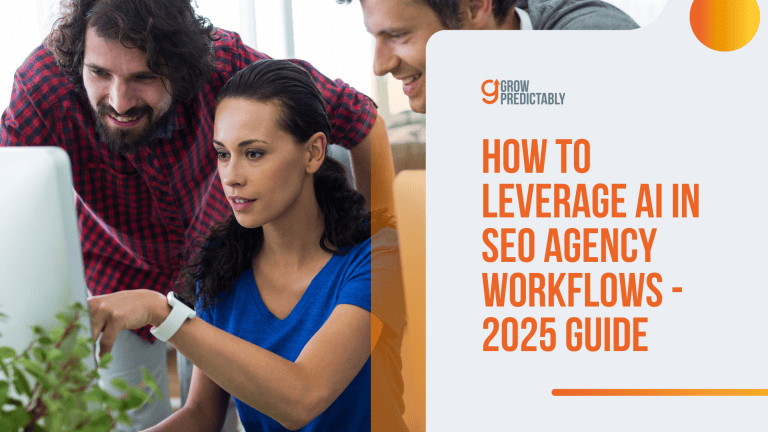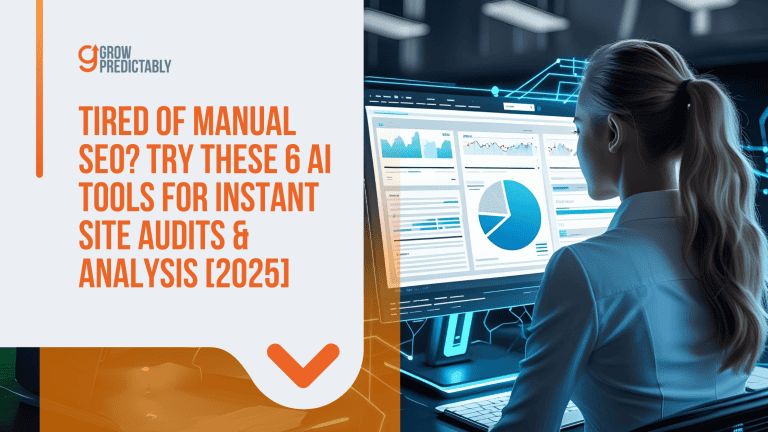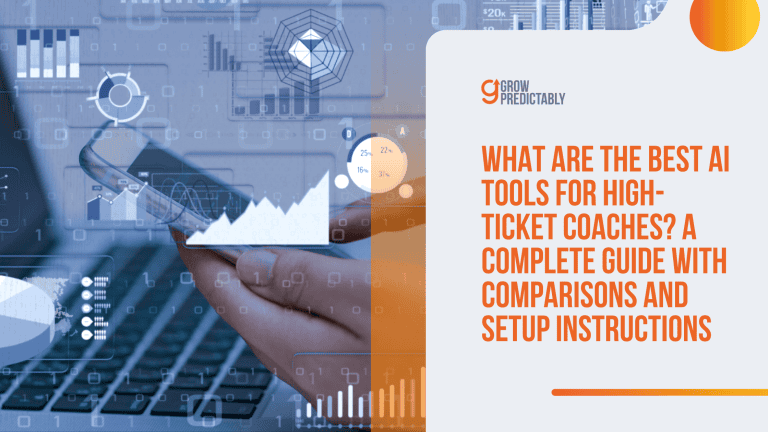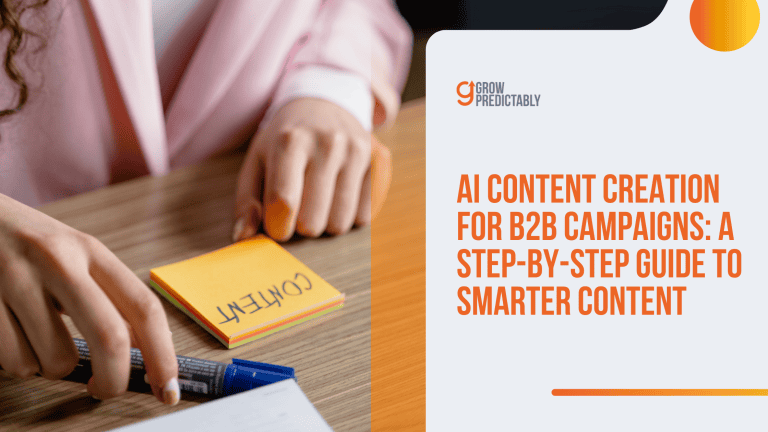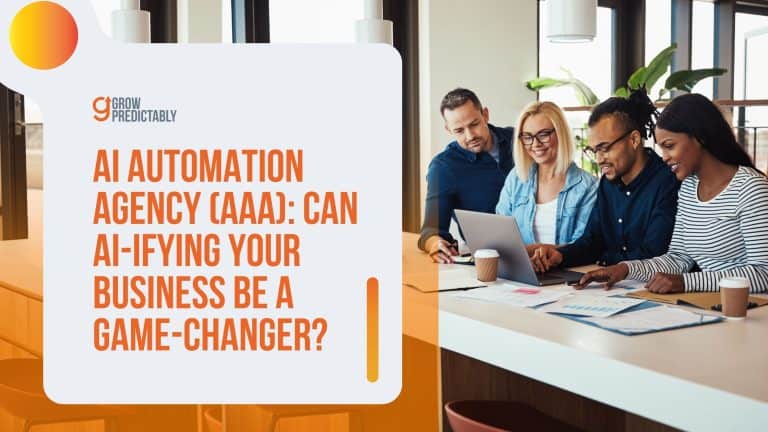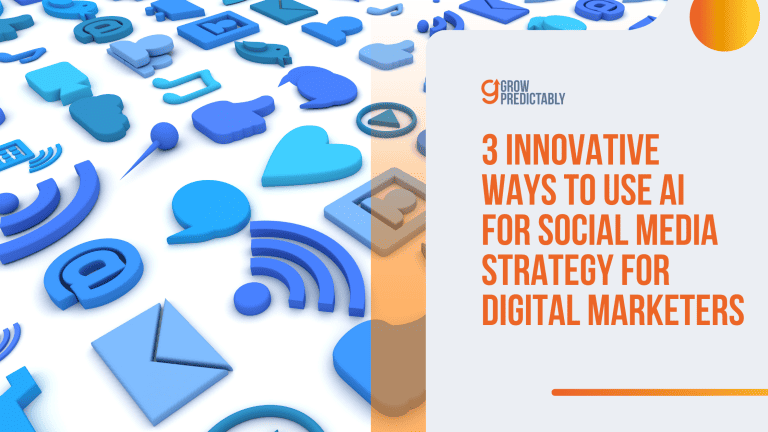The Future of B2B Ads: AI-Powered B2B Ad Campaign Management
Most B2B ad campaigns bleed budget and time.
But what if they could actually run—and improve—themselves?
With AI-powered B2B ad campaign management, smart agencies see up to 40% less campaign oversight time. (Source)
Imagine letting AI allocate spend, qualify leads, and spot winning audiences while your team focuses on strategy, not spreadsheets.
Want to know how top teams are turning complicated, manual campaigns into growth engines?
Let’s get into this power guide!
TL;DR
AI revolutionizes B2B ad campaign management by optimizing targeting, personalization, and budgeting in real-time, significantly reducing manual workload. This results in lower costs and higher conversion rates. Agencies can leverage AI to streamline complexities of long B2B sales cycles, ensuring consistent, data-driven improvement and client satisfaction.
KEY TAKEAWAYS
- Identify current campaign friction points that AI can alleviate, like manual bid adjustments and lead scoring.
- Choose AI platforms that align with B2B requirements, focusing on CRM integration and account-based marketing features.
- Foster team buy-in by framing AI as a supportive tool, running small workshops, and documenting AI-generated successes.
AI’s Role in Managing Your Advertising Campaigns
What if your next digital marketing campaign could optimize itself in real time?
Imagine waking up to discover your B2B ads had automatically shifted budget overnight from underperforming segments to high-converting audiences as part of innovative marketing strategies—without you lifting a finger.
AI-powered B2B ad campaign management refers to using intelligent systems to streamline targeting, personalization, budgeting, and lead qualification in longer, multi-stakeholder buying cycles.
It’s not about replacing your marketing team—it’s about giving them a strategic assistant that handles the routine complexity so humans can focus on creative and relationship-driven tasks.
For B2B marketers, the pain points are all too familiar:
- lengthy sales cycles that drain resources
- disconnects between marketing and sales teams
- frustratingly low funnel conversion rates
These challenges create a perfect storm where campaigns demand constant attention but deliver unpredictable results.
This is where AI changes everything.
How AI Transforms B2B Campaign Management
AI brings operational simplicity and scalable predictability to your ads and overall marketing campaigns.
When engagement signals show a particular job title is responding better than expected, AI can dynamically realign your segment priorities.
When conversion likelihood shifts based on new data, your bidding strategy and marketing strategies adjusts automatically.
The impact goes beyond convenience.
A Boston-based SaaS agency reduced time managing campaigns by 40%, eliminating bottlenecks that were burning out their midsize team.
Instead of spending hours tweaking bids and analyzing reports, their marketers focused on strategy and creative development—the work that actually drives growth.
What makes this particularly valuable for B2B is how AI handles the unique complexity of longer buying cycles and multiple decision-makers.
The systems continuously learn from interactions across channels, building increasingly accurate models of what works for specific audience segments, fine tuning your marketing efforts.
Key Metrics That Matter
When AI takes the wheel, you’ll see improvements across critical metrics:
- Reduced CPL (Cost Per Lead) through smarter audience targeting
- Faster-qualified pipeline velocity as AI identifies high-intent signals
- Lower customer acquisition costs from optimized channel allocation
- Higher conversion rates through personalized messaging
The real value isn’t just in these numbers—it’s in the predictable client acquisition and lower internal strain they represent.
Your team gains confidence knowing campaigns are constantly optimizing toward business goals, not just vanity metrics.
AI Terms You Should Know
The following terms represent technologies that work together to create a system that’s constantly learning and improving—without requiring constant human intervention.
Predictive Analytics
Using historical data to forecast future outcomes, like which leads are most likely to convert.
Lead Scoring
Automatically ranking prospects based on their likelihood to become customers.
Natural Language Processing (NLP)
AI’s ability to understand and generate human language, enabling better ad copy and content personalization.
Machine Learning
Systems that improve automatically through experience, continuously refining campaign performance.
Real-Time Bidding
Automated auction-based ad buying that happens in milliseconds as users load webpages.
Key AI Capabilities Transforming B2B Ad Campaigns
With AI, your B2B ad campaigns are optimizing themselves in real-time.
They’re learning from every interaction.
They’re guiding prospects through a seamless journey from first touch to loyal customer, optimizing your marketing efforts along the way.
This isn’t a scene from a science fiction movie—it’s what AI is making possible right now across the Customer Value Journey, transforming how marketing campaigns are managed.
A Preview of the AI-Enhanced Customer Value Journey
AI powered tools are revolutionizing how we guide B2B prospects through each stage of the buying process.
Let’s explore how these intelligent systems transform your campaigns from disconnected touchpoints into a cohesive, responsive journey:
Awareness: Smarter Targeting and First Impressions
The journey begins with getting in front of the right people.
AI excels here by:
- Predictive audience targeting: AI powered predictive analytics analyzes historical campaign data to identify high-potential segments you might have missed.
- Intelligent bid management: “Using Metadata’s AI bid optimization during the Awareness stage led to 34% lower CPCs for a B2B agency targeting IT buyers.”
- Cross-channel coordination: AI ensures your marketing campaigns and their messages appear consistently across platforms where your B2B buyers actually spend time.
How many prospects never see your message simply because manual targeting couldn’t identify them?
AI closes these gaps by constantly refining audience segments based on real-time signals regarding customer interactions.
Engagement: Capturing Interest Through Personalization
AI deepens connections by enhancing engagement with tailored content:
- Dynamic content personalization: AI studies customer behavior to present the most relevant content based on industry, role, and browsing habits.
- Engagement prediction: Systems pinpoint prospects likely to engage further, enabling better resource allocation.
- Conversation optimization: NLP tools adjust messaging to resonate with various segments automatically.
“One agency using AI-powered engagement tools reported: ‘We increased content consumption by 47% by letting AI match content topics to visitor behavior profiles.'”
Subscribe: Converting Interest to Ongoing Relationships
At this stage, AI vitalizes a crucial transition:
- Lead scoring automation: AI continually assesses behaviors signaling subscription readiness.
- Form optimization: Smart forms dynamically adjust fields to boost completion rates by up to 28%.
- Timing intelligence: AI identifies optimal moments to present subscription prompts based on insights involving customer interactions.
“After implementing AI-driven subscription timing, we witnessed a 32% jump in form completions with no changes to the offer itself,” a B2B software agency noted.
Convert: Turning Subscribers into Customers
The conversion stage benefits tremendously from AI’s ability to identify signals that indicate purchase readiness, enhancing campaign execution:
- Buying intent signals: AI monitors behavioral patterns that correlate with purchase readiness.
- Personalized conversion paths: Different decision-makers see different paths based on their role in the buying committee.
- Objection prediction: AI analyzes hesitation patterns and presents content that addresses specific concerns.
How many leads never become customers simply because your touchpoints weren’t optimized in sequence?
AI helps answer this by tracking customer behavior throughout the full journey and identifying drop-off points.
Excite: Creating Exceptional Customer Experiences
AI ensures new customers feel validated post-conversion:
- Onboarding personalization: AI customizes welcome sequences based on previous engagement.
- Success prediction: Systems identify customers needing additional attention to ensure satisfaction, analyzing customer interactions for better insights.
- Automated check-ins: AI triggers personalized outreach at vital milestones.
“A SaaS agency leader shared that their AI-generated email sequence increased demo bookings by 41% and freed the CMO from manual outbound calendar management during the ‘Excite’ stage.”
Ascend: Expanding Customer Relationships
AI excels in spotting account expansion opportunities:
- Upsell opportunity detection: Systems recognize readiness for additional services.
- Usage analysis: AI tracks product use to suggest timely upgrades.
- Relationship health monitoring: Early alerts reveal engagement declines before they escalate into issues.
Advocate: Creating Brand Champions
AI facilitates turning satisfied customers into advocates:
- Advocacy potential scoring: AI identifies customers likeliest to become references based on ongoing engagement patterns.
- Testimonial generation assistance: Systems help craft compelling testimonial requests tailored to their specific experiences.
- Social sharing optimization: AI determines optimal timing and platforms for advocacy campaigns.
Promote: Amplifying Customer-Driven Growth
AI amplifies customer-driven promotion impact:
- Referral targeting: Systems identify customers with networks matching your ideal profiles.
- Incentive optimization: AI tests various referral incentives to determine what motivates your specific customer base.
- Impact tracking: Attribution models evaluate the full value of customer-driven promotion across channels.
5-Step Guide to Implementing AI in B2B Ad Campaign Management
There are five critical steps—miss one, and you risk confusing tech signals with strategy.
Let’s walk through how to build an AI-powered system that delivers predictable growth without drowning your team in complexity.

1. Identify Campaign Frictions
Start by pinpointing where your current campaigns get stuck:
- Are you spending hours on manual bid adjustments?
- Does lead scoring happen offline in spreadsheets?
- Do you struggle to connect platform data with actual sales outcomes?
Pro Tip: Don’t just list problems—quantify them.
“Our team spends 12 hours weekly adjusting bids” gives you a clear benchmark to measure AI improvements against.
A B2B manufacturing client discovered they were spending 68% of marketing efforts on repetitive tasks that could be automated.
Identifying these friction points first ensures you’re solving real problems, not just adding shiny tech.
2. Evaluate AI Platform Fit
Not all AI platforms are created equal for B2B campaigns.
Compare tools based on:
- B2B Alignment: Does the platform understand longer sales cycles and multi-stakeholder decisions?
- CRM Integration: Can it connect seamlessly with Salesforce, HubSpot, or your existing stack to support both marketing and sales teams?
- Cost Flexibility: Does pricing scale with your agency’s growth?
- ABM Capabilities: If your clients target accounts with multiple decision-makers, prioritize tools with account-based marketing features.
Pro Tip: Request platform-specific case studies from B2B agencies similar to yours.
A tool that worked wonders for B2C might struggle with complex B2B buying journeys.
3. Integrate with Your Tech Stack
Successful AI implementation means connecting your new platform with:
- CRM systems (Salesforce, HubSpot)
- Lead capture forms and landing pages
- Existing analytics dashboards
- Communication tools your team already uses
This integration creates a unified data ecosystem where AI can learn from every touchpoint.
Pro Tip: Start with one critical integration rather than attempting to connect everything at once.
A B2B software agency found that connecting their AI tool just to Salesforce first—before adding other integrations—reduced marketing campaigns’ implementation headaches by 60%.
4. Launch AI-Driven Workflows
With your foundation in place, it’s time to activate AI-powered processes:
- Set up A/B tests that automatically shift budget to winning creative
- Implement NLP segmentation that groups leads by intent signals
- Configure real-time bid adjustments based on lead quality scores
- Create automated nurture paths that respond to engagement patterns
Pro Tip: Document each workflow clearly so your team understands what decisions AI is making about customer interactions automatically versus where human oversight remains essential.
One Boston-based agency reduced campaign recovery time from 14 days to just 3 by letting AI tools identify underperforming segments and reallocate budget in real-time—while keeping creative decisions with their human experts.
5. Train & Troubleshoot
AI implementation isn’t “set it and forget it.”
Success requires:
- Regular team training sessions on platform updates
- Clear roles defining who monitors AI decisions
- Feedback loops to improve algorithm performance
- Processes for handling exceptions and edge cases
Pro Tip: Create an “AI Strategy Lead” role within your agency—someone who bridges technical understanding with strategic thinking to maximize platform value and improve campaign execution.
When things go wrong (and they sometimes will), having documented processes prevents panic.
A marketing agency working with healthcare clients created a simple “AI Decision Review” checklist that reduced troubleshooting time by 47% when campaigns needed human intervention.
Privacy and Compliance Considerations
As you implement AI, maintain ethical standards and legal compliance:
- Ensure your chosen platform offers GDPR compliance features for secure and effective campaign execution
- Understand how customer data is used in AI learning
- Maintain transparency with clients about AI’s role in campaigns
HubSpot’s privacy practices provide a solid example of responsible AI implementation in marketing contexts, balancing automation with appropriate data governance.
Audit your current tool stack—where could AI replace repetition?
Which campaign tasks consume disproportionate time with minimal strategic value?
These are your prime candidates for AI transformation.
The right implementation approach turns AI from a confusing buzzword into a practical growth engine that delivers predictable results while freeing your team from campaign management drudgery, ensuring smooth campaign execution.
Comparing Top AI Tools for B2B Ad Campaign Management
Imagine if one AI tool could cut your lead costs in half while another might waste your budget on poorly qualified prospects.
Let’s find out which platform delivered that 3X lead gen ROI you’re looking for.
Choosing the right AI tool for your B2B campaigns isn’t just about features; it’s about crafting effective marketing strategies with the ideal tools.
It’s about finding technology that fits your specific marketing challenges and client needs.
Before diving into our comparison matrix, let’s understand what separates truly effective B2B AI tools from general marketing automation platforms.
B2B marketing requires specialized capabilities that consumer-focused tools often lack.
Long sales cycles, multiple decision-makers, and complex purchase journeys demand AI that can:
- Track engagement across extended timeframes
- Identify and target buying committees (not just individuals)
- Optimize for high-value conversions rather than simple clicks
- Integrate deeply with your existing CRM and sales processes
With these needs in mind, we’ve evaluated the top contenders based on seven critical dimensions that matter most to B2B agencies.
Here is the table with the ‘Ease of Use’ column removed:
| Tool | Automation | Personalization Depth | Predictive Analytics | B2B Relevance | CRM Integration | Pricing Flexibility |
|---|---|---|---|---|---|---|
| Metadata.io | 9/10 Autonomous campaign optimization; auto-budget allocation | 8/10 Account-based personalization; buying committee targeting | 9/10 Predictive ROAS; conversion likelihood scoring | 9/10 Built specifically for B2B | 8/10 Native Salesforce, HubSpot, Marketo | 7/10 Starts at $3,500/mo; volume discounts |
| HubSpot AI | 8/10 Campaign workflow automation; content optimization | 9/10 Deep behavioral personalization across channels | 8/10 Contact scoring; revenue attribution | 8/10 Strong B2B focus with SMB emphasis | 10/10 Native CRM plus 1,000+ integrations | 8/10 Tiered plans from $800/mo; modular pricing |
| Jasper | 7/10 Content generation; ad copy creation | 7/10 Tone customization; brand voice adaptation | 5/10 Limited predictive capabilities | 6/10 General purpose with B2B templates | 6/10 Via Zapier and API connections | 9/10 Plans from $49/mo; team scaling options |
| AdCreative.ai | 8/10 Ad creative generation; A/B testing | 8/10 Dynamic creative optimization; audience matching | 7/10 Creative performance prediction | 7/10 Cross-industry with B2B options | 7/10 HubSpot, Salesforce via API | 8/10 From $29/mo; usage-based scaling |
| 6sense | 9/10 Intent-based targeting; account identification | 9/10 Buying stage personalization; account insights | 10/10 Advanced intent prediction; revenue forecasting | 10/10 Pure B2B ABM platform | 9/10 Deep CRM and MAP integrations | 5/10 Enterprise pricing; annual contracts |
Metadata.io

Metadata.io is a G2 Leader in AI-Powered Advertising, 2023.
Metadata shines in audience targeting automation and campaign optimization.
It’s the go-to platform when you need to quickly find lookalike B2B audiences and optimize spend across channels.
“We saw a 52% reduction in cost per qualified lead within 60 days of implementing Metadata.
The platform automatically shifted budget to highest-performing channels without us lifting a finger.” — Marketing Director, B2B SaaS Agency
Best for: Agencies managing multiple B2B clients with defined ICP and ABM strategies.
HubSpot AI

HubSpot AI is a MarTech Breakthrough Award Winner for Best Marketing Automation Platform, 2023.
HubSpot’s AI capabilities excel in integration and end-to-end campaign management.
Its strength lies in connecting ad campaign performance directly to pipeline and revenue metrics.
“We saw 27% lower CPL in 3 months after switching to HubSpot AI.
But the real game-changer was seeing exactly which campaigns generated closed business, not just leads.” — B2B agency founder
Best for: Agencies that want unified marketing, sales, and service data with AI-powered insights.
Jasper

Jasper is an AI Breakthrough Award for Best Overall AI Solution, 2023.
Jasper focuses on AI powered content creation rather than campaign management.
It’s ideal for creating personalized ad copy, landing pages, and nurture emails at scale.
“Our creative team saved 15 hours per week on ad copy variations, allowing us to test 3x more messaging combinations for our manufacturing clients.” — Content Director, B2B agency
Best for: Content-focused agencies needing to scale creative production for ad campaigns.
AdCreative.ai

AdCreative.ai is a Top AI Design Tool by Product Hunt, 2023.
AdCreative.ai specializes in NLP-powered ad creative generation and optimization.
It can automatically generate variants based on performance data.
“We increased click-through rates by 31% for our B2B technology clients by using AdCreative’s AI-generated variants.
The platform learned which visual elements resonated with technical buyers.” — Digital Director, Technology Marketing Agency
Best for: Agencies struggling with creative testing and optimization for B2B campaigns.
6sense

6sense is a Forrester Wave Leader for ABM Platforms, 2023.
6sense offers the most sophisticated intent data and account identification capabilities, helping identify in-market accounts before they even reach out.
“6sense helped us identify buying committees 70% earlier in their journey, allowing our clients to engage prospects before competitors even knew they were shopping.” — ABM Strategy Director
Best for: Enterprise-focused agencies with clients selling complex solutions with long sales cycles.
Budget Considerations
Most tools offer entry-level plans, but B2B-specific platforms generally start higher:
- Starter budgets ($500-$1000/mo): Consider HubSpot AI or AdCreative.ai
- Mid-tier budgets ($1000-$5000/mo): Metadata and 6sense offer scaled-back options
- Enterprise budgets ($5000+/mo): Full-featured implementations of Metadata or 6sense
Remember that tool cost should be evaluated against potential efficiency gains and ROI improvement.
One agency reported: “Metadata costs us $4,000 monthly but saves us $12,000 in staff time and delivers $50,000 in additional pipeline.”
Making Your Selection
When evaluating these tools for your agency’s needs, consider:
- Client portfolio complexity: How many decision-makers are typically involved in your clients’ sales processes?
- Integration requirements: Which CRMs and marketing platforms must connect seamlessly?
- Team capacity: Do you need fully autonomous optimization or guided assistance?
- Creative demands: Is your bottleneck in targeting or content creation?
- Budget flexibility: Can you start with core features and expand?
The right AI tool simplifies capture and other marketing efforts, not adds chaos.
Whether you manage five clients or fifty, look for platforms that reduce friction in your existing workflows rather than forcing new processes.
As you review this comparison, remember that the step-by-step implementation guide in the previous section provides a framework for successful adoption regardless of which tool you select.
Your choice should align with the specific campaign frictions identified in step one of that process.
Which AI platform will power your next breakthrough B2B campaign?
Smart Steps to Measuring Your AI-Powered Ad Campaigns
Agencies using AI dashboards improve client ROI visibility by up to 40% — according to 2023 Forrester research.
Compared to traditional campaigns, these campaigns could actually tell you exactly what’s working and what needs fixing before results go sideways.
Let’s break down how AI driven insights transform your measurement from guesswork into a predictable growth engine:
1. Define KPIs (Beyond Basic Metrics)
Stop chasing vanity metrics!
AI helps you focus on what actually moves business forward:
SQL Generation Rate
How quickly marketing-qualified leads become sales-qualified.
Pipeline Velocity
Time from first touch to closed deal.
Cost Per Lead (CPL)
With AI qualification scoring to filter quality.
Multi-Touch Attribution
Which combinations of touchpoints drive conversions.
AI platforms can now automatically tag and track these deeper metrics without manual data entry.
One agency owner told me, “We used to track clicks and impressions. Now our AI system shows us exactly which message combinations are creating sales conversations.”
2. Use AI for Predictive Benchmarking
Here’s where things get exciting.
Instead of looking backwards at what happened, AI helps you see what’s coming:
- Forecast lead quality before spending your entire budget
- Use predictive analytics to identify which accounts show buying signals based on engagement patterns
- Predict next-best-actions for specific prospect segments
- Compare campaign performance against similar historical campaigns
A B2B software agency used this approach to redirect budget mid-campaign, focusing on segments showing higher intent signals.
The result?
They reduced cost-per-SQL by 32% by catching underperformance early.
3. Visualize Data in Dashboards
AI doesn’t just crunch numbers—it tells the story behind them:
- Auto-generated weekly performance narratives (“Campaign A is showing 27% higher engagement but 12% lower conversion than expected”)
- Anomaly detection highlighting unexpected shifts in performance
- Opportunity spotting across audience segments
- Automated recommendations in plain English
Instead of spreadsheets and guesswork, your AI interface simply says: pause this marketing campaign’s ad creative, increase spend here, or this message is resonating with financial services decision-makers.
4. Run Continuous Optimization Loops
This is where AI truly shines—creating a never-ending improvement cycle:
Audience Refinement
AI continuously segments and re-segments based on response patterns.
Message Testing
NLP detects when messaging starts showing fatigue or diminishing returns.
Budget Reallocation
Automatic shifting of spend toward highest-performing segments.
Creative Recommendations
Suggesting new elements based on engagement patterns.
One agency I worked with set up these optimization loops and saw their client reporting transform from “here’s what happened” to “here’s what we’re already improving based on last week’s signals.”
Human + AI Partnership
While AI handles the heavy lifting of data processing and pattern recognition, human oversight remains critical in several areas of your marketing strategies:
Creative Strategy
AI can optimize existing messages but humans still drive core positioning.
Relationship Nurturing
Personal touchpoints with high-value accounts.
Ethical Considerations
Ensuring targeting remains appropriate and respectful.
Most leading AI platforms now include GDPR-compliant protocols with clear explainability features that show exactly how decisions are being made.

The real power comes when you shift from reacting to campaign data to anticipating outcomes.
Imagine knowing which creative approach will resonate with a specific segment before launching, or identifying which accounts are most likely to convert next week.
Now imagine scaling these insights across all your client campaigns with the help of AI tools before they even underperform…
What would your agency accomplish using AI driven insights if you could redirect the hours spent manually analyzing spreadsheets toward strategic thinking and creative development instead?
Top Challenges to AI Ad Management & How to Overcome Them
If your CRM has messy data and your team fears losing creative control, AI can feel risky.
The truth?
These concerns are normal – and they’re also totally solvable with the right approach.
Let’s tackle the most common roadblocks head-on:
Data Hygiene Challenges
AI systems need clean, structured data to deliver accurate insights.
Many agencies discover their CRM is filled with incomplete contact records, duplicate entries, and inconsistent tagging.

The Fix:
- Run a focused 2-week CRM clean-up sprint
- Start with your highest-value accounts first
- Create simple data standards for all new entries
- Consider a data validation tool that flags issues in real-time
A marketing agency serving tech startups found that after a 10-day data cleanup, their AI lead scoring became 43% more accurate at predicting qualified opportunities.
The key wasn’t perfect data—it was consistent data, interpreted through AI powered tools.
Change Resistance
Team members worry AI will replace their jobs or diminish their creative contributions.
The Fix:
- Host small workshops showing AI as an assistant, not a replacement
- Start with one repetitive task AI can handle (like reporting)
- Celebrate and share early wins that free up creative time
- Frame AI as “delegation to a digital junior strategist”
A 12-person creative agency in Denver overcame objection fatigue by reframing AI tasks exactly this way.
They started by having AI draft initial ad copy variations, which designers and writers then refined.
After seeing how much time this saved, the team began requesting more AI assistance.
Overreliance Anxiety
Leadership worries about becoming too dependent on AI or losing the human touch that clients value.
But there are simple measures you can take to help internal organization and your clients embrace AI.
The Fix:
- Establish clear “AI is the co-pilot, not the pilot” guidelines
- Create a simple checklist of what AI handles vs. what needs human review
- Document where AI suggestions improved performance
- Maintain client-facing communication with a personal touch

A healthcare marketing agency found that after shifting to gradual automation, their operational workload dropped 36%—freeing up 12 weekly hours that they reinvested in strategy sessions with clients.
This actually strengthened client relationships rather than weakening them.
Budget Constraints
AI tools seem expensive when viewed as new line items rather than productivity multipliers.
The Fix:
- Start with free trials of AI platforms to prove value
- Calculate ROI based on time saved and performance improved
- Begin with one campaign to show measurable results
- Consider entry-level plans that offer core functionality
“We couldn’t justify the full enterprise package,” shared one boutique agency founder.
“So we started with basic AI analytics and documented every hour saved.
After three months, we had proof that even the basic tool paid for itself three times over in productivity gains.”
Skill Gap Concerns
Your marketing and sales teams worry they lack the technical expertise to implement AI effectively.
The Fix:
- Identify one team member who’s naturally tech-curious
- Invest in focused training (many platforms offer free onboarding)
- Start with user-friendly tools with intuitive interfaces
- Join communities where other agencies share implementation tips
Which adoption blocker is slowing your pipeline growth—and what small win could be achieved using AI powered tools to start unblocking it?
Remember, the agencies seeing the biggest gains didn’t try to transform everything overnight.
They started with one challenge, solved it with AI, and built momentum from there.
Engaging Your Team and Clients with AI-Driven Campaigns
Imagine the possibilities if your agency could transform skepticism into enthusiasm—both internally and externally—while implementing AI-powered campaigns.
One agency managed to rebuild client confidence after months of erratic performance.
They used AI dashboards that gave clients ‘X-ray vision’ into campaign changes.
The secret wasn’t just the technology—it was how they brought everyone along on the journey.
Let’s explore how to engage both your team and clients through each stage of the Customer Value Journey.
The goal is to turn AI from a buzzword into a trusted growth partner.
Awareness: Building Knowledge Foundation
Begin by creating psychological safety around AI adoption:
- Run learning sessions where team members can explore AI tools in a no-pressure environment.
- Share internal demos showing practical applications like automated ad optimization or AI powered content creation.
- Normalize questions and concerns rather than pushing for immediate adoption.
“We dedicated two hours every Friday to ‘AI playground’ sessions,” shares a marketing director from a B2B SaaS agency.
“This gave our team permission to experiment without performance pressure.”
Engagement: Getting Hands-On
Transition from theory to practice by:
- Creating small cross-functional teams to test specific AI applications.
- Inviting healthy skepticism and documenting both wins and challenges.
- Pairing AI champions with more hesitant team members to build confidence.
For clients, engagement means transparent communication about how AI enhances—not replaces—your strategic thinking and campaign execution.
Show them simple before/after examples of campaign performance improvements.
Subscribe: Building Continuous Feedback Loops
Maintain momentum through structured feedback:
- Implement feedback forms tied to weekly AI feature trials.
- Track sentiment shifts as team members gain comfort with new workflows.
- Create AI insight digests that highlight discoveries from your experiments.
“Our weekly ‘AI wins and fails’ email became the most-read internal communication,” notes a LinkedIn B2B Institute case study participant.
“It made learning visible and collaborative.”
Convert: Launching Strategic Pilots
Now it’s time to formalize AI adoption:
- Launch AI-powered pilot campaigns aligned to specific client KPIs.
- Set clear success metrics that matter to both your team and clients.
- Document workflow changes to quantify time savings and performance gains.
When presenting to clients, focus on outcomes rather than technical details: “Our AI-assisted targeting helped identify three new buyer segments showing 2x engagement compared to traditional methods.”
Excite: Celebrating and Sharing Wins
Build emotional investment through recognition:
- Highlight team members who embrace new AI workflows.
- Celebrate small wins publicly: “Team reduced ad revision requests by 42%”.
- Create client success spotlights that connect AI capabilities to business results.
This excitement stage is where both internal adoption and client trust accelerate.
When people see tangible benefits, resistance naturally decreases.
Ascend: Deepening Integration
Expand AI capabilities systematically:
- Upsell deeper AI integrations based on proven pilot results.
- Develop AI-enhanced service packages that command premium pricing.
- Create client-specific AI playbooks that document your approach.
“After seeing initial results, our client doubled their budget specifically for our AI-powered ABM campaigns,” reports a Metadata AI Training success story.
“They wanted more of what was working.”
Advocate: Amplifying Success Stories
Turn believers into champions:
- Gather short testimonials from team members and clients.
- Document case studies with specific metrics and emotional outcomes.
- Encourage team members to share learnings at industry events.
The advocate stage transforms AI from a tool into a competitive advantage that both your team and clients proudly promote.
Promote: Expanding Your AI Influence
Scale your impact through knowledge sharing:
- Invite clients to events/webinars showcasing how your agency uses AI.
- Create thought leadership content based on your unique AI approach.
- Build communities of practice where clients can learn from each other.
This final stage positions your agency as an AI leader while creating a virtuous cycle of continuous improvement with AI powered tools.
Engagement Checklist
Before moving forward, ask yourself:
- Is your team narrating AI’s value to clients beyond technical features?
- Are clients emotionally invested in AI outcomes beyond just the data?
- Have you created safe spaces for questions and concerns?
- Are you celebrating both learning moments and successes?
- Have you documented workflow improvements and time savings?
Now that your team backs the journey, how will you scale these engagement practices agency-wide?
The strategies outlined in the measurement section will help you track adoption progress.
The change management approaches covered earlier provide frameworks for overcoming resistance.
Remember—engagement isn’t about forcing adoption but creating an environment where both team members and clients discover value on their terms.
When people feel ownership of the AI journey, transformation happens naturally.
FAQs
Start Small, Finish Big with AI Ad Management!
You don’t have to master it all today—just take the next step.
Remember that Boston-based SaaS agency we mentioned?
They started with just one AI-powered campaign.
Three months later, they had reduced management time by 40% and their team was finally able to focus on strategy instead of spreadsheets.
What could your agency accomplish if you freed up that kind of time and brainpower?
The future of B2B marketing isn’t coming—it’s here.
The question isn’t whether AI will transform campaign management, but whether you’ll be leading that transformation or playing catch-up.
Which path will you choose?

